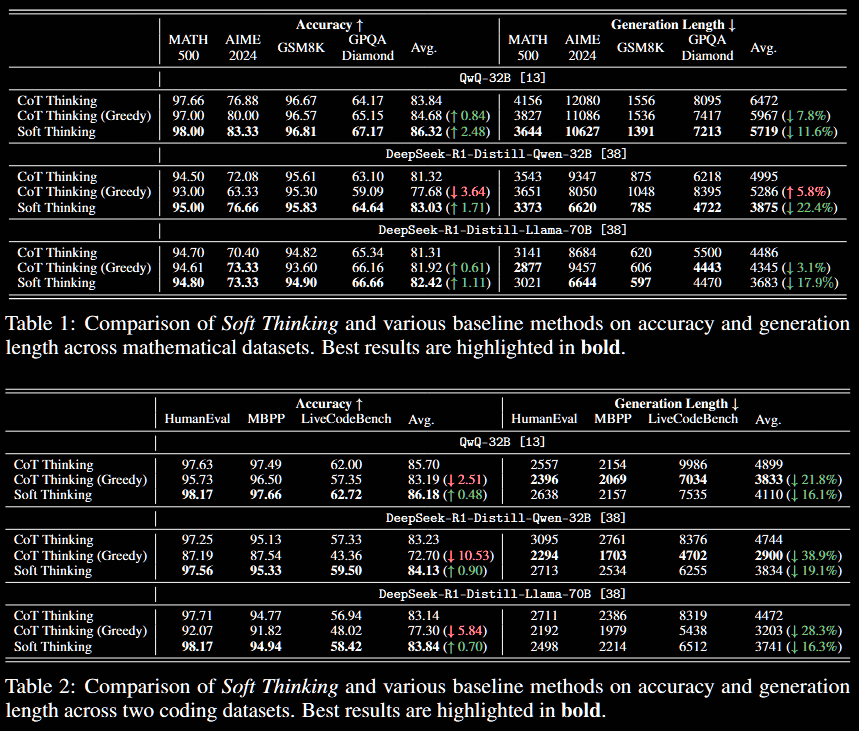Soft Thinking Summary
Soft Thinking: Unlocking the Reasoning Potential of LLMs in Continuous Concept Space
- 2025-05; Zhang, He, Yan, Shen, Zhao, Wang, Shen, Wang
High-Level Ideas
- Training-free method that enables human-like 'soft' reasoning
- Standard Chain-of-Thought (CoT) sample one token per step and follow that path, potentially abandoning valuable alternatives
- Soft Thinking generates concept tokens in continuous concept space corresponding to LLM-produced distribution over the vocab (at given step)
- It's related to superposition of all possible tokens: it's a convex combination, weighted by probabilities
- This flexibility enables the exploration of different reasoning paths, and avoids making hard (consequential) decisions too early
- A cold stop (entropy threshold) is used to mitigate out-of-distribution issues
Related Papers
-
Let Models Speak Ciphers: Multiagent Debate through Embeddings
- main idea (weighted average of embedded tokens) seems exactly the same
- CIPHER paper also has a debate element
-
Text Generation Beyond Discrete Token Sampling ("Mixture of Inputs")
- Mixes the distribution (soft thinking) with the sampled token (CoT)
- When only using distribution, calls it Direct Mixture; performs badly, but no cold stop
-
Training Large Language Models to Reason in a Continuous Latent Space (COCONUT)
-
Reasoning by Superposition: A Theoretical Perspective on Chain of Continuous Thought
Some Details
Instead of injecting the random, one-hot encoded token, after embedding, into the LLM, the concept token is injected back:
inject
where / is the selection probability/embedding of the -th vocab item.
The theoretical justification is based on linear approximations in the expression
here, is the -th (intermediate reasoning) token. To emphasise, is the probability of the next token given the input and intermediate reasoning tokens . Once some stopping criterion is achieved, the model outputs an answer, denoted .
This expansion entails exponentially-in- many paths, indexed by the choice of intermediate reasoning tokens. If we only expanded one layer,
In expectation,
Linearising the previous expression about its mean, (ie, replacing random by its non-random mean ),
The approximation is repeated given :
Iterating,
In contrast, discrete CoT replaces each summation with sampling a single token, which discards the mass from all other paths. Soft thinking preserves the distribution through the concept tokens, whilst collapsing the exponential path summation to a single forward pass.
A cold stop is also implemented, where the entropy is tracked in real time. This is to address issues in which the continuous concept tokens place the model in an out-of-distribution regime. If the entropy (ie, uncertainty) of a concept token drops below a threshold, the process stops. A basic ablation study is conducted; with details below.
Results
In summary, I'd suggest that the accuracy increase is modest, but the generation length reduction is significant.
The first table is the accuracy (higher → better) and the second the generation length (lower → better).

The soft thinking results all utilise a cold stop, with threshold optimised for the problem at hand. An ablation study is conducted regarding cold stop—namely, is forced, ensuring the cold stop is never activated.
The four lines in the table below correspond to different strategies.
-
COCONUT-TF: the training-free COCONUT approach simply feeds the previous hidden state as the next input embedding.
-
Average Embedding: the (embeddings of the) top 5 tokens are averaged and fed.
-
w/o Cold Stop: soft thinking without cold stop—ie, enforced.
-
w/ Cold Stop: full soft thinking, with cold-stop threshold optimised (swept).

This is all summarised in a figure given above the abstract.
